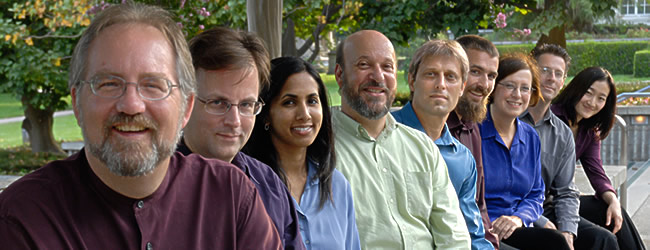Richard Wagner
Album leaf for Betty Schott
Max Reger
Quintet for Clarinet & Strings, Op. 146
Johannes Brahms
Trio for Violin, Horn & Piano, Op. 40
Albumleaf for Betty Schott
by RICHARD WAGNER
“Here is the albumleaf composed for you! It contains the first musical promptings that I have had since the exhausting work of Götterdämmerung.” Wagner wrote this charming Albumleaf for Betty Schott in 1875 after the completion of Der Ring des Nibelungen as a thank-you present to his publisher. A relaxed compositional “victory lap,” the movement is similar to the Siegfried Idyll in its unification of ideas in a one movement form. The Albumleaf demonstrates a charming human side to this complex vegetarian, ideologue, anti-Semite, Saint Bernard-loving genius that was all frustratingly rolled into one personality. An interesting postscript: the 1876 world premiere of Der Ring des Nibelungen in Bayreuth took place the same year as the first complete performance of Goethe’s Faust, the world premieres of Verdi’s Requiem, and Die Fledermaus by Johann Strauß, Jr.
Quintet in A major for Clarinet & Strings, op. 46
by MAX REGER
Max Reger was born to be the most transitional figure in European music history—his last name is a palindrome. This birthright symbolized a virtuosity that would enable him to go backwards and forwards in novel and inspiring ways. His extraordinary fluidity with tonal harmony would see no distinction between melody and counterpoint. Perhaps more than any other composer, Reger reconciled the seemingly irreconcilable worlds of Wagner and Brahms. His ability to achieve this epochal task is due to his profound knowledge of the music of Johann Sebastian Bach. Roll all these talents into one figure and you find the missing link that transformed tonality into the new world of late Mahler and early Schoenberg, Berg and Webern.
Reger’s music is today caught in a vicious whirlpool. On the one hand, he is too complicated for conservative performers to master, and on the other, he is not liberal enough for new music pioneers. What has been lost in this Scylla and Charybdis is an output of great originality, extraordinary melodic counterpoint, prophetic density, and an undeniably epic quality guiding the way to the idealist world of a Symbolist Ver Sacrum. The autumn twilight of Klimt’s gold leaf painting sounds in every bar of a major Reger composition.
Describing the events of a Reger composition is ultimately a musical tour of late Romanticism. To attempt to hear a single melody from the changing shapes of his Clarinet Quintet, Op. 146, as in a comparable work of Brahms, is to misunderstand the reconciliation Reger achieved between Wagner and Brahms. What does emerge is a continuous ebb and flow, the tossing of a harmonic Raft of the Frigate Medusa that puts Wagner’s endless melody in a Brahmsian context of abstract structure and form. The genuine contact point between Brahms and Wagner is their focus on individual intervals generating long term structure (which they inherited from Beethoven and which Mahler would use to rethink harmonic gravity in his mammoth symphonies). Reger forges their similarities into a true new music for his era, an artistic achievement of profound proportion, which makes Reger an essential element of the musical landscape. He united opposite aesthetics in a prodigious way.
This final work of his fast and intense output is in excelsis Reger’s most successful chamber composition, and is a perfect introduction to his music for the first time listener. The fusion of melody and counterpoint is beguiling. The music glows with the hue of a full glass of Late Harvest Rieslingtrockenbeerenauslese. And the melancholy of the piece is genuine—a sad reminder that, like Mozart and Brahms before him, Reger consciously turned toward an A major clarinet quintet as a valedictory, sadly at the age of 43.
Trio in E flat for Violin, Horn & Piano, op. 40
by JOHANNES BRAHMS
Written when Brahms was 32 years old, the Op. 40 Trio is both polished and filled with the vigor of early adulthood. Associated with his stay in Baden- Baden during the summer of 1865, the very landscape seems to have inspired Brahms’ musical urges, for he pointed out a spot in the wooded heights to a friend and said “I was walking along one morning, and as I came to this spot the sun shone out and with it this theme.” The combination of violin, horn and piano was unusual in Brahms’ day and it has been said that the choice of instruments was made because these were the three instruments Brahms could play. The first movement begins with the theme which visited Brahms in the Baden-Baden woods. The overall effect is one of lyric geniality and warmth. The second movement includes many instances of imposing a duple rhythm over a 3/4 measure. The trio section in the dark key of A flat minor includes a melodic phrase similar to the posthorn call found in Mahler’s Symphony No. 3. The third movement was a musical response by the composer to the death of his mother, and the impression created is of articulating a profound secret until the tension can no longer be contained. Near the end of the movement Brahms looks into what was at the time the musical unknown, mysteriously predicting the principal, rollicking theme of the final movement in a soft verklärung of a chorale for violin and horn. The last movement should be played, as Clara Schumann commented about a contemporary performance, “as if shot out of a pistol.”
— Jeff von der Schmidt

